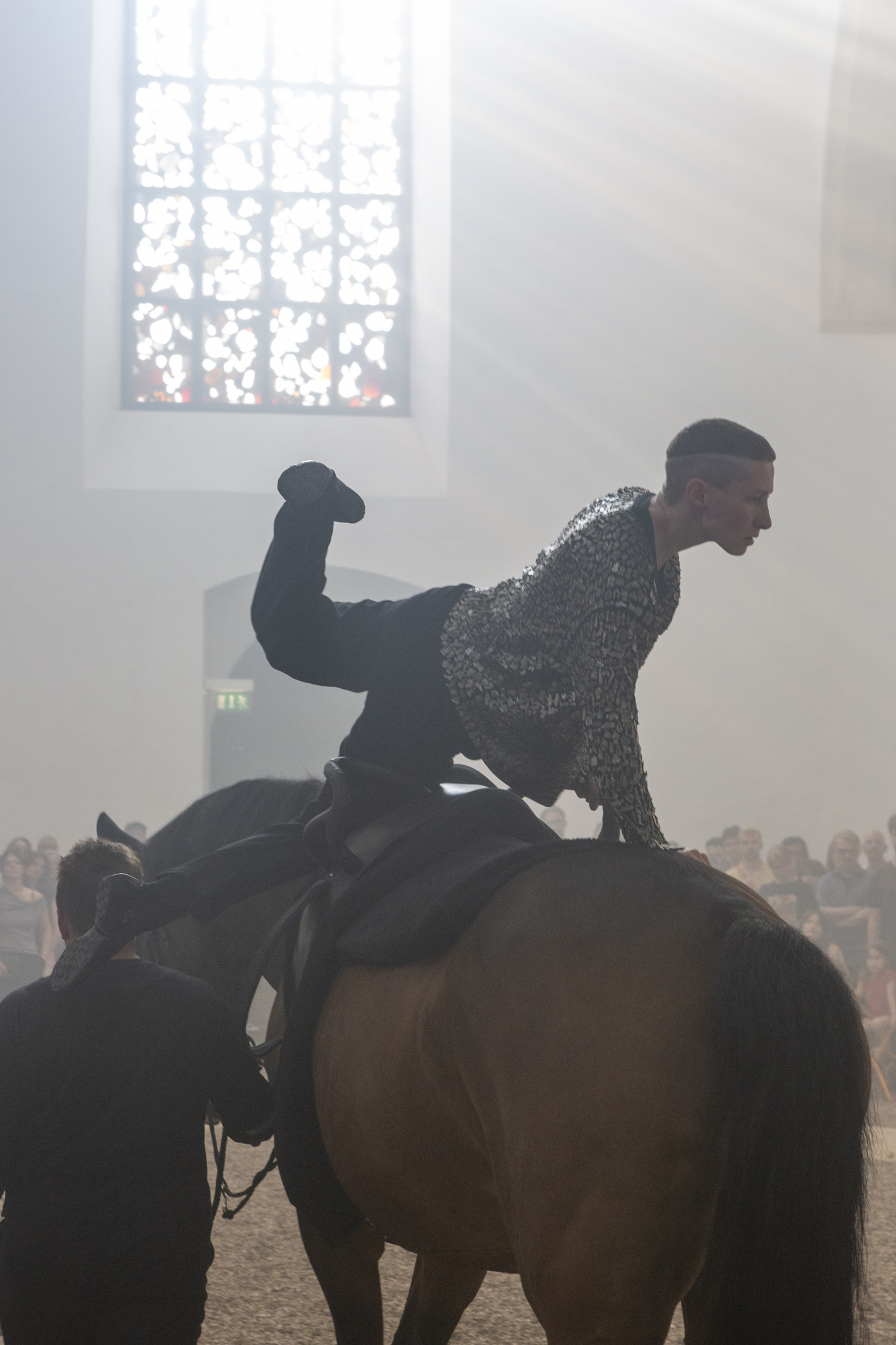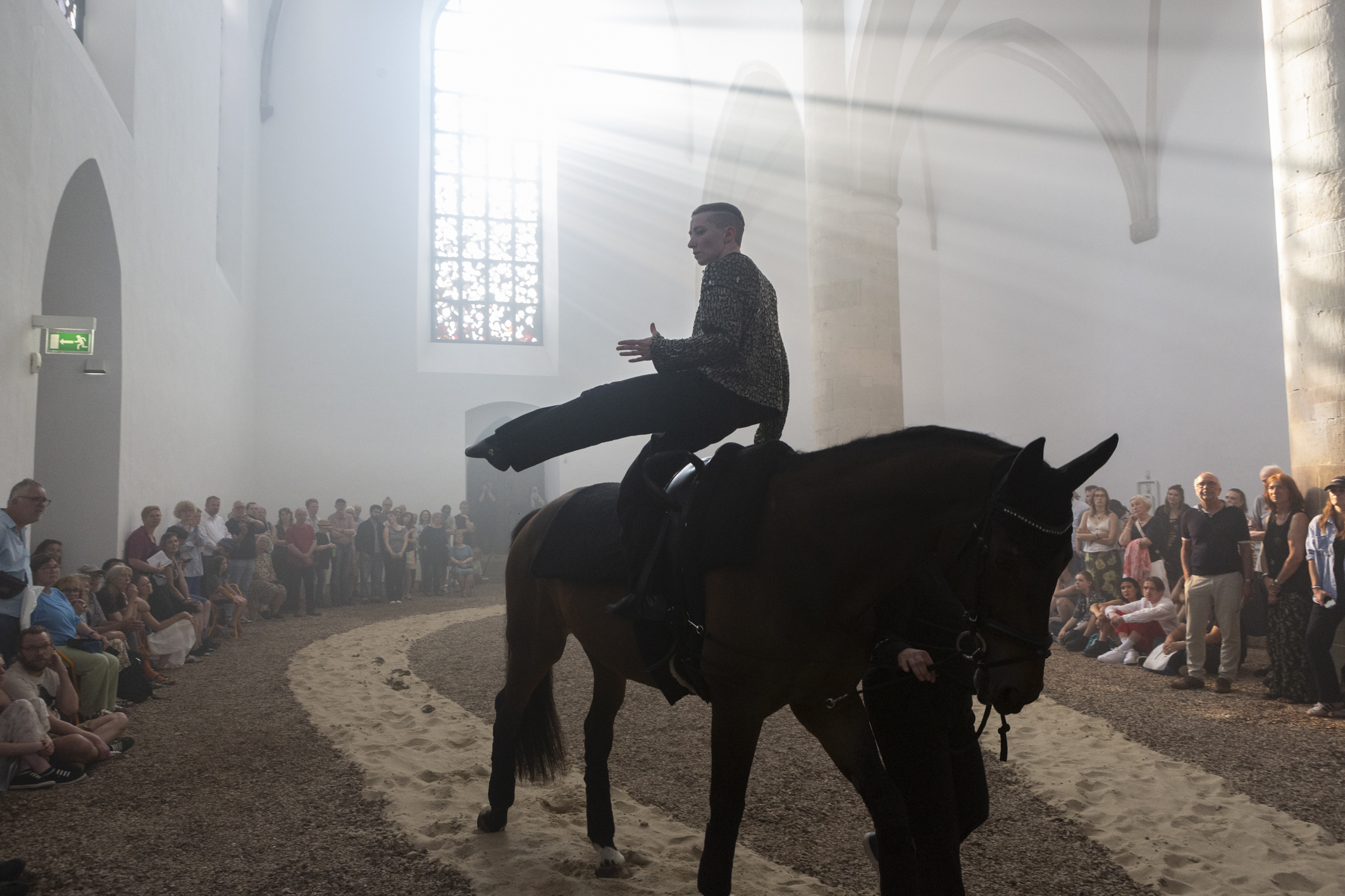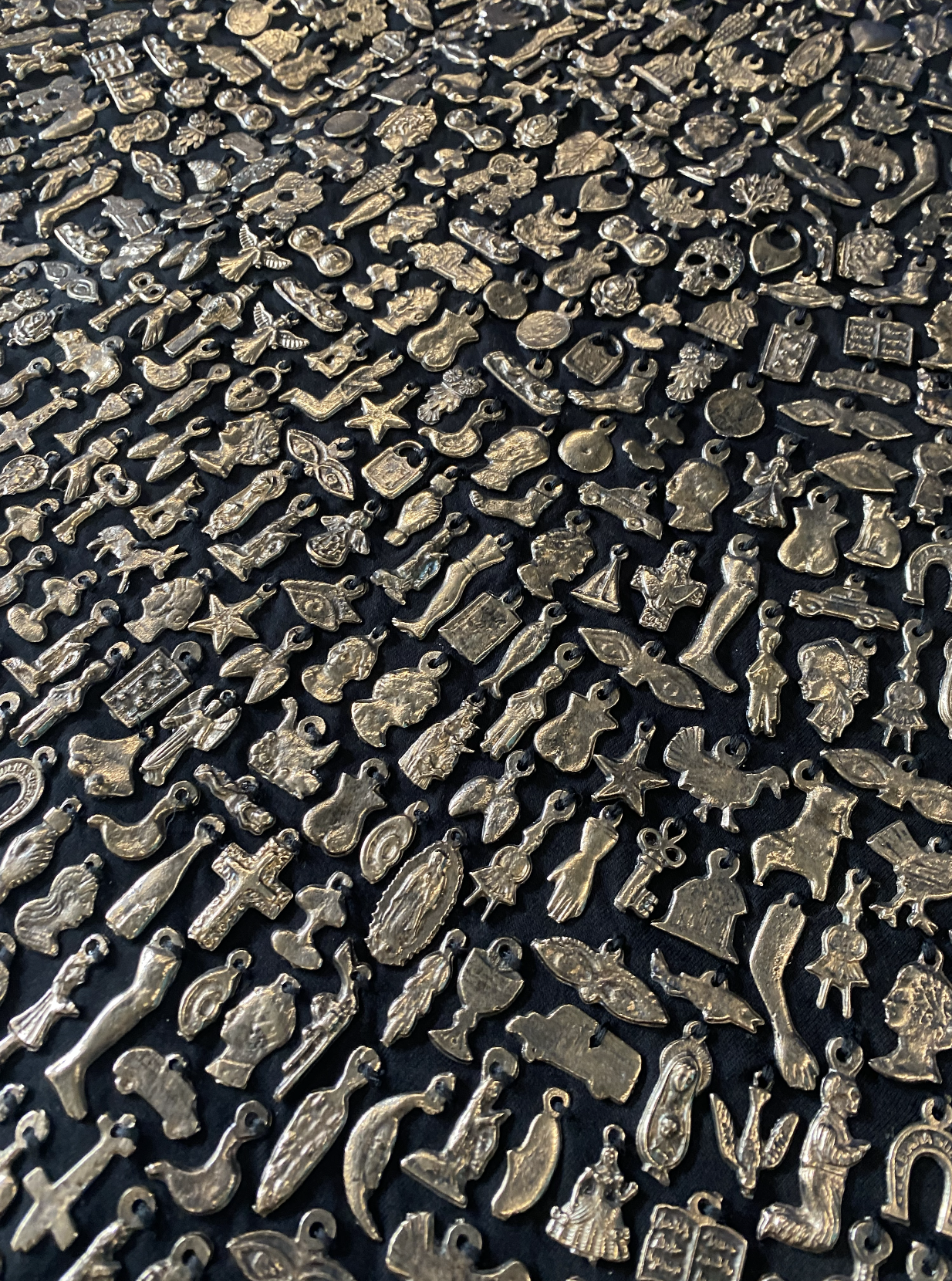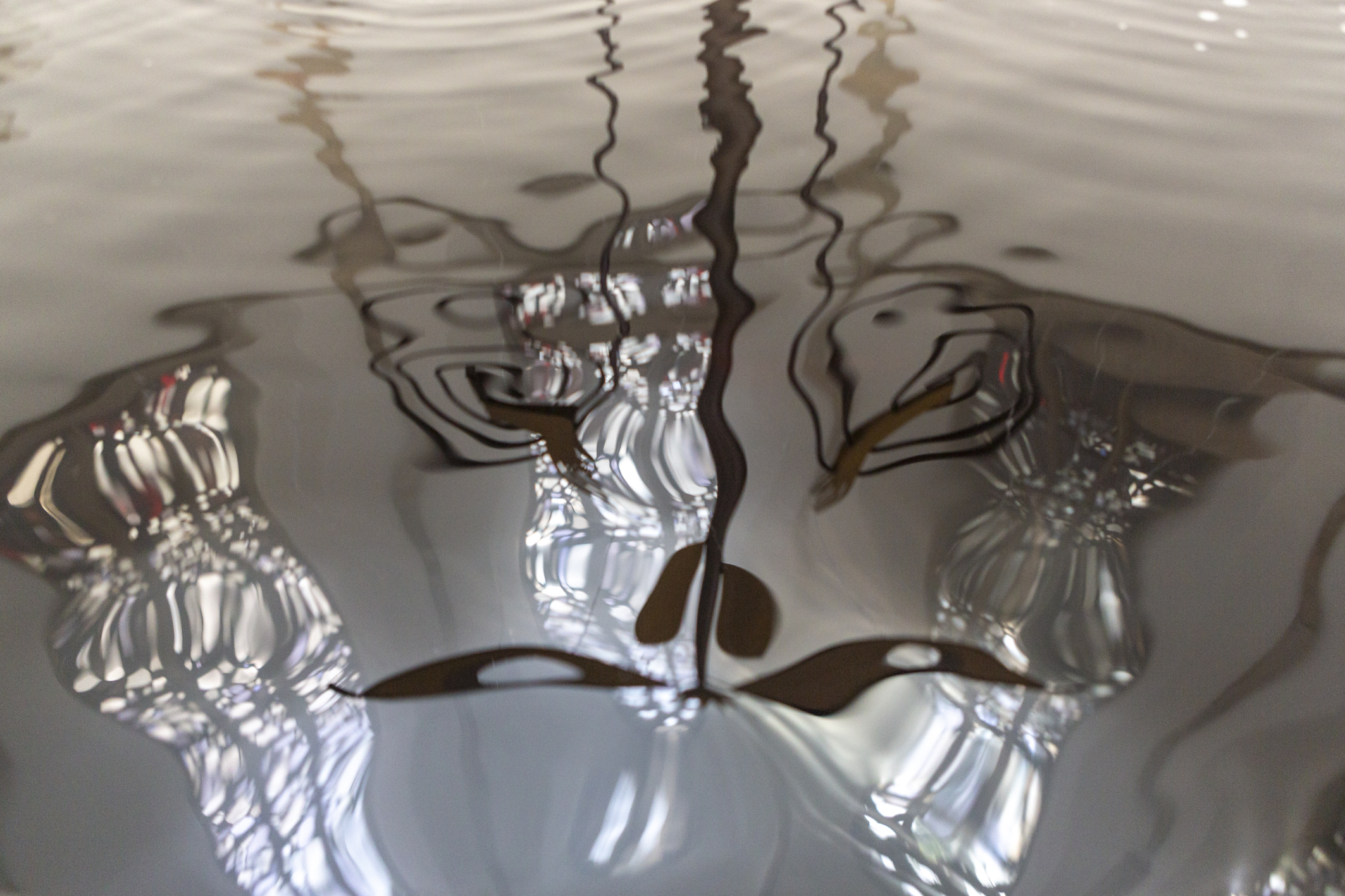Epona
I was born in Germany, not just anywhere, but on a military base. It was war, its logistics, its bureaucracies, that brought me here. This unchosen beginning lingers beneath my work like a latent scent: something almost imperceptible, but persistent. In EPONA, it surfaces with force, within a space shaped not only by devotion and transformation, but also by conquest, collapse, and survival.
For years, I’ve navigated two seemingly distant realms: belief systems and the hierarchy of the senses. At first glance, one operates through ritual and myth, the other through perception and physiology. But they are both structures of control and possibility, systems we rarely interrogate because we are born into their logics. They both belong to architectures of reality, cultural and somatic frameworks we rarely question, because we are born inside of them. And because they shape us, early on, at the level of the body, we often mistake them for truth. Among the senses, smell is perhaps the most syncretic: intimate and uncontrollable, bound to memory and geography, yet resistant to translation. It leaks across categories. Like belief, it bypasses reason and enters through the skin.
EPONA offers not a stable system, but a field of entangled thresholds. It asks what happens when inherited frameworks, religious, sensory, cultural, are made soft again. Not to romanticize rupture, but to explore how transformation is enacted through contact, through friction, through embodiment. Syncretism is key here, not as a harmonious blend, but as a tactic. A way of living within imposed structures without fully surrendering to them. It names the cultural negotiations that occur under pressure: when belief systems fuse not because they agree, but because survival requires it. It is how gods pass through empires, how rituals mask insurgencies, how bodies carry knowledge that official histories refuse.
This is not healing as resolution, but as labor. A recursive tending. If there is seduction here, it is not escape, but sensory accountability. What we smell, what we crush underfoot, what lingers on our skin; these are not metaphors, but materials of history.
I’ve long been drawn to Epona, a celtic goddess that transverse Europe acquiring meaning and layering beliefs; she’s a goddes of horses, calvary, fertility and a psycopomp, and to other so-called “minor” goddesses, not because they lack power, but because they persist outside centralized cosmologies. Their influence is syncretic by nature: adaptive, local, partial. They accompany thresholds. Epona, guardian of passage and protection, was absorbed into empire but never fully owned. Her worship survived precisely because it transformed, reshaped by terrain, by mobility, by necessity. She is not a symbol of purity, but of permeability.
In her name, this work becomes a choreography of return, not to origin, but to complexity. To the layered sediments of care and conquest, sanctity and violence, loss and endurance, to transverse universes. EPONA is not a shrine to wholeness. It is an altar to the fractured, the hybrid, the inherited. It is a place to pause, to smell, to remember, and to begin again, without illusions of purity, but with the radical softness and porosity that transformation demands.
WORKS
Ojo de Agua (Fountain)
Material: Brass, copper, integrated water pump, oceanic scent
Year: 2025
Dimensions: 2687 mm height
Ojo de Agua is the central sculpture in EPONA, installed in the choir, the most charged space in the church, where voice once met vault. Shaped like a tree with spiral hands and open eyes, it circulates water through its stem and weeps gently through its eyes. An oceanic scent lingers in the air.
In many parts of Latin America, ojos de agua—springs—are not only sources of water, but portals: sites of memory, emotion, and spiritual communication. Revered across Indigenous and Afro-diasporic traditions, they are thresholds between the physical and the ancestral. This sculpture echoes that reverence, but also acknowledges how such portals have been mapped, mined, and mythologized through colonial desire.
Throughout EPONA, there is a quiet reckoning with histories of violence, particularly the entanglements of care and conquest, of sanctity and control. Ojo de Agua gestures toward these contradictions. Ojo de Agua merges sacred European traditions of holy fountains with the extractive fantasy of the “fountain of youth,” a myth that drove Ponce de León’s doomed expedition into the Caribbean. But here, the fountain is not redemptive. It does not promise eternal life, but insists on presence. It mourns. It watches. It remembers.
The hands speak of offering and labor; the eyes of vigilance and grief. The sea scent is not just nostalgia, it’s a trace of migration, rupture, and ecological precarity. As scent, water, and form combine, the sculpture becomes a syncretic altar, one that refuses purity and instead holds contradiction: sanctity and empire, care and conquest, erosion and renewal.
By merging scent, water, and form, Ojo de Agua becomes an altar to memory and embodiment, to care and to the ancestral ocean that connects and divides, a place to pause, to weep, to remember, and to begin again.
Epona (Rite of Return) The Poetics of Collapse
Material: Live performance in collaboration with Joran Yonis and Tanja Evers (RV Schwagstorf); trained horse, ceremonial garment with ex-votos
Year: 2025
This live performance unfolds along an infinity loop drawn through the church nave. A vaulting artist rises, collapses, and rises again on a moving horse. Each movement resists perfection—fragile, rhythmic, unresolved. The figure invoked is Epona: a psychopomp, a guide, a syncretic goddess of fertility, death, and transition. Worshipped across Gaul, the Balkans, and Rome, her cult survived through absorption. But even within empire, she remained local, animal, liminal.
The rider, Joran Yonis, wears a ceremonial garment made of ex-votos—metallic offerings shaped as body parts, traditionally left at altars in exchange for healing. Here, they do not clink or shimmer. They hang heavy, reflective. A reliquary of pain and persistence. They do not dramatize trauma; they accumulate it, hold it, survive it.
The body becomes an archive: one that does not seek to erase harm, but to carry it visibly. This is not catharsis. It is endurance. The horse, too, is double: creature of sanctity and empire, tenderness and violence. Horses have carried saints and conquistadors alike. In this looped rite, the animal reanimates the church not as neutral ground, but as a site haunted by entwined histories of militarization, domination, and worship.
Rite of Return is not nostalgia. It is a demand: to re-enter history not through monument, but through movement. Through weight. Through scar.
Every Step is a World
Material: Seashells from the North Sea
Year: 2025
Every Step is a World transforms the floor of the nave into a field of shells—thousands, gathered from the North Sea. Visitors walk across them. With each step, a crack. A sound of fracture, of presence. A sonic residue that cannot be undone.
Drawn from a coastline shaped by tides, trade, extraction, and erasure, the shells carry histories of both oceanic life and human violence. They speak of migration routes and maritime borders. Of ecological precarity and colonial trade. Their scent—briny, mineral—is not decorative. It is indexical. A lingering trace.
Here, breaking is not failure. It is process. To be broken is not a permanent state of defeat
but an active state of transformation. A seashell becomes sand, becomes glass, becomes a wine glass on the floor. The work resists stasis. The floor does not hold; it registers. Each movement marks the fragility of terrain and the consequences of passage. Every Step is a World becomes both stage and score: a ritual of accountability in which the sacred is not abstract, but material. Not separate from the body, but activated by it.
Ritual Currents
Material: Scent Compositions, Engraved Bronze Boxes Year: 2025
Ritual Currents is a scent installation composed of four olfactory compositions that generate an invisible cartography, navigation points or single voices that converge into an atmospheric symphony. Green - Gravitopism, Red - Soft Steel, Yellow - Umbra, and Blue - Oceanic, diffuse through engraved bronze boxes discreetly placed throughout the church. Each scent forms a sensory field, an atmosphere charged with histories that resist visibility. These are elemental accords, invoking fluid landscapes; rivers, veins, oceans, magma, the circulatory forces that irrigate the living. Everything is in motion.
GREEN - GRAVITOPISM
Hildegard von Bingen often used the Latin word “viriditas” to express a kind of divine life-force, greenness, or vitality, closely linked to growth, renewal, and spiritual illumination through nature.
To grow is to split oneself in two directions. In plants, this is not a metaphor but a biological necessity: gravitropism governs the orientation of growth, driving roots downward into the subterranean while shoots and leaves stretch skyward. This opposition is not conflict but condition. Green Gravitropism proposes scent as a space to meditate on this polarity, not only vegetal, but existential. Drawing from the logic of the rhizome, (non-hierarchical, multiplicitous, decentralized, and always in motion) the composition suggests that resilience lies in multidirectional movement. It begins underground:
Geosmin, the microbial molecule released when soil is struck by rain, speaks of droughts ended and thirst quenched, it is the scent of humidity. Cis‑3‑hexenyl salicylate is part of the “green leaf volatiles” (GLVs), a group of compounds emitted by plants when they are damaged or cut, it’s part of the plant’s communication and defense system. In this sense, it’s both a marker of growth, rupture, and trauma. Bay oil, distilled from a plant native to the Antilles and long used in Caribbean folk medicine against pain, introduces diasporic dimensions of healing: the botanical as pharmakon, both cure and resistance. Tomato leaf absolute ruptures the pastoral with its acrid green sharpness, it restores a sensory dimension we've largely lost. While the tomato fruit is everywhere, its plant’s sharp, green scent, once common in gardens and on hands, is now unfamiliar. Violet leaf absolute is metallic, dewy, earthy. The violet has long been a symbol of modesty, mourning, and hidden strength. In Roman antiquity, it was associated with the underworld, used in funerary rites, and planted on graves. And cis‑3‑hexenol, or “leaf alcohol,” anchors the formula in motion: it is what we smell when grass is cut, when a plant is wounded and releases its chemical SOS. Together, these molecules perform a tension between root and canopy, darkness and clarity, decay, and bloom. Green Gravitropism does not resolve this tension, it dwells in it, asking: what can we learn from the way plants grow?
YELLOW - UMBRA
“You burn me.” —Sappho, translated by Anne Carson
Every light casts a shadow. Umbra moves within this paradox, an olfactory meditation on what is felt but not fully seen. If yellow is the color of clarity, Umbra explores its inverse: the warmth beneath brightness, the residue of radiance, the outlines that glow in the dark, the feeling of fire close to the skin. Inspired by Hildegard von Bingen’s visions of “lux vivens” (living light), this composition speaks in fire.
The scent opens with Labdanum, a resin with deep roots in ancient rituals, obtained from the Cistus ladanifer shrub, native to the Mediterranean region. It has been used since antiquity, originally collected from the beards of goats that grazed on the plant. Birch tar adds a burnt, smoky quality, evoking charred wood and the memory of charded meat, traditionally used in folk medicine and tanning, birch tar carries antimicrobial properties and a long-standing association with preservation and transformation.Vetiver, a rooted grass native to India and widely grown in Haiti, is used in traditional medicine to cool the body, calm the nerves, and support circulation, it anchors the composition with its dry, green-brown weight and connects us to the Caribbean. Finally, Palo Santo, traditionally used in Indigenous spiritual practices across South America for cleansing and protection, introduces a soft, resinous brightness, balsamic and sweet, it can also echo the long forgotten resins that once perfumed the church turned kunsthalle. While Palo Santo evokes ritual and ancestral continuity, its presence also raises questions about cultural appropriation and ecological strain, as demand for the wood has intensified beyond its original context. In Umbra, it functions as both a fragrant trace of sacred fire and a reminder that even spiritual materials can become sites of extraction.
The composition glows from within, like aromatic embers and smoke, a traditions ancient and transcultural as fire itself.
RED - SOFT STEEL
This composition isolates the metallic trace of blood, its sharp, minerality, through Rose Oxide, a molecule that smells of ruptured green stems and electrical charge. Stripped from the flower’s romantic narrative, it reveals something cooler: volatile, metallic, almost surgical. Its sharpness echoes the ex-voto garment worn by vaulting performer Joran Yonis, resembling chainmail, the armor of medieval soldiers. It is a garment of protection that invokes a legacy of violence. Here, scent becomes a medium to interrogate the aesthetics of protection and inheritance, the wound and the weapon, the ritualization of violence, and the choreography of fear.
Civetone, once extracted from animal glands and now synthesized, stays disturbingly close to instinct: sweat, heat, the trace of adrenaline. Globalide, a synthetic musk, evokes skin and closeness. Raspberry Ketone, high-pitched and synthetic, slices through the blend with a chemical red brightness. It brings synesthetic intensity, like a cosmetic memory of fruit that never existed, blood that appears only on screen.
BLUE - OCEANIC
To dissolve is not to disappear. In water, things lose form to find suspension. Blue – Oceanic considers this movement, diffusion, not direction, as a condition of being. Where Green was grounded in polarity, Blue enters a more unstable state: one of drift, saturation, and osmotic thresholds, (to highlight the porosity and malleability of systems, one of the backbones of my practice). It is less about growth than about immersion, what happens when bodies lose their borders, like a catterpillar in its cocoon.
The composition began compulsively, as an antidote to personal yearning. To formulate is to grasp at atmosphere. Here, the need was to capture the fiction of a real oceanic landscape, not as rendered through commercial scents: synthetic, overstated, impossibly clean.
Calone gives this impression its volume: crystalline, marine, but ultimately abstract, more like the smell of a wave in a 90’s commercial than the sea itself. Floralozone, another ozone-rich compound, reinforces this artificial blue: airy, metallic, stretched thin. Helional, somewhere between aldehyde and aquatic floral, softens the edges and brings lift, like the scent of air before a storm. These are molecules of fantasy and simulation.
Against this engineered expanse, Seaweed Absolute brings resistance: thick, saline, and faintly decomposed. It speaks to the sea as a living body, depth and tidal, dancing with the moon, while, birthing, bleaching and rotting. Gamma-Octalactone, with its milky coconut note, recalls skin exposed to sun and lotion, softening the composition with a memory of contact. A Salt Accord draws the scene to a close: mineral, evaporated, the trace left behind.
Blue – Oceanic is not a return to nature, but a confrontation with its mediation. It holds together the clean and the corrosive, the synthetic shimmer and the biological residue. It asks: what does it mean to long for the sea we no longer touch? How can we metabolize this longing into protection?
–
Scent functions as a portal; not only to memory and individual experience, but to relation, to proximity, to shared histories. Together, these environments form a fluid topography, an astral cartography not drawn but inhaled. Each composition marks a point in an olfactory constellation, guiding the body through space not by sight, but by scent. Like syncretism, scent resists fixed form. It seeps, merges, adapts. It survives translation without becoming transparent, it gathers meaning through contact and dispersion.
Here, smell becomes sensorial architecture. Not ornamental, but foundational. It lingers after bodies move on. It marks space not with presence, but with persistence. These invisible currents ask: how are we shaped by what we cannot name, but cannot ignore?
In Ritual Currents, scent becomes a medium of both memory and disobedience. Like the bloodlines and belief systems that travel beneath dominant narratives, it moves slowly, insistently, through matter. A quiet insurgency.
Ritual Currents extends the exhibition’s exploration of migration, histories of violence and resistance, embodiment, and transformation, situating smell as a carrier of knowledge that resists capture. Like the sea, sap, or blood, scent moves, slowly, insistently, through matter and memory. It lingers after presence, echoing the traces we leave behind and the terrains we carry within, fertilizing the future.















